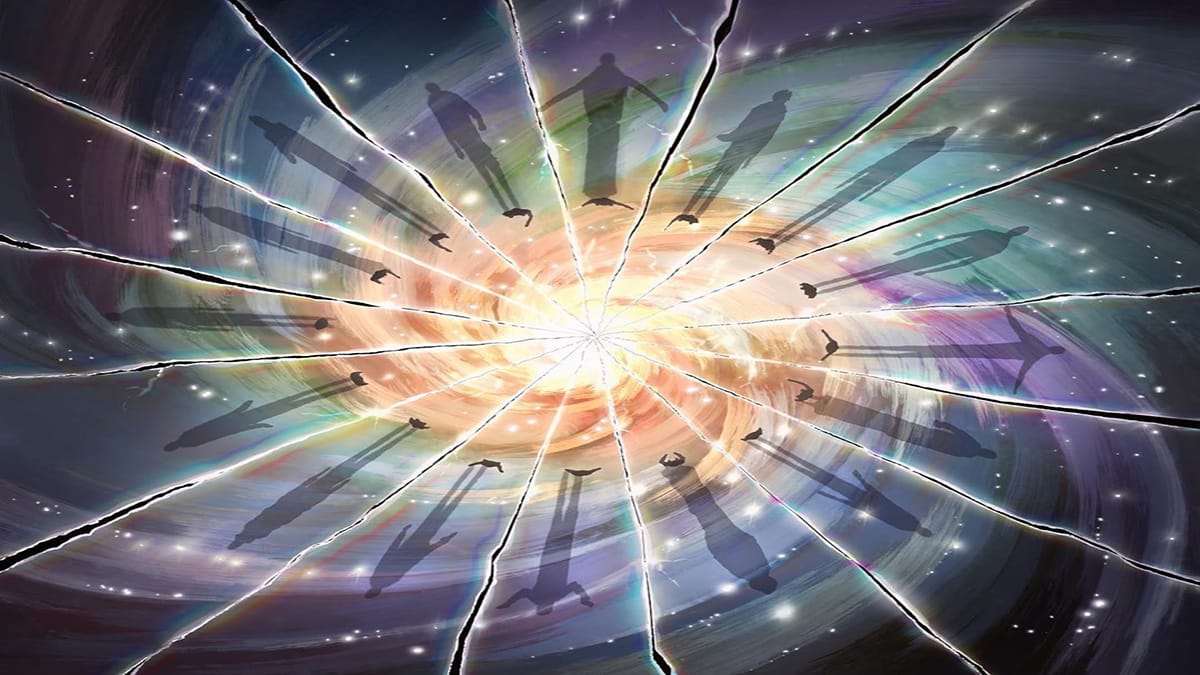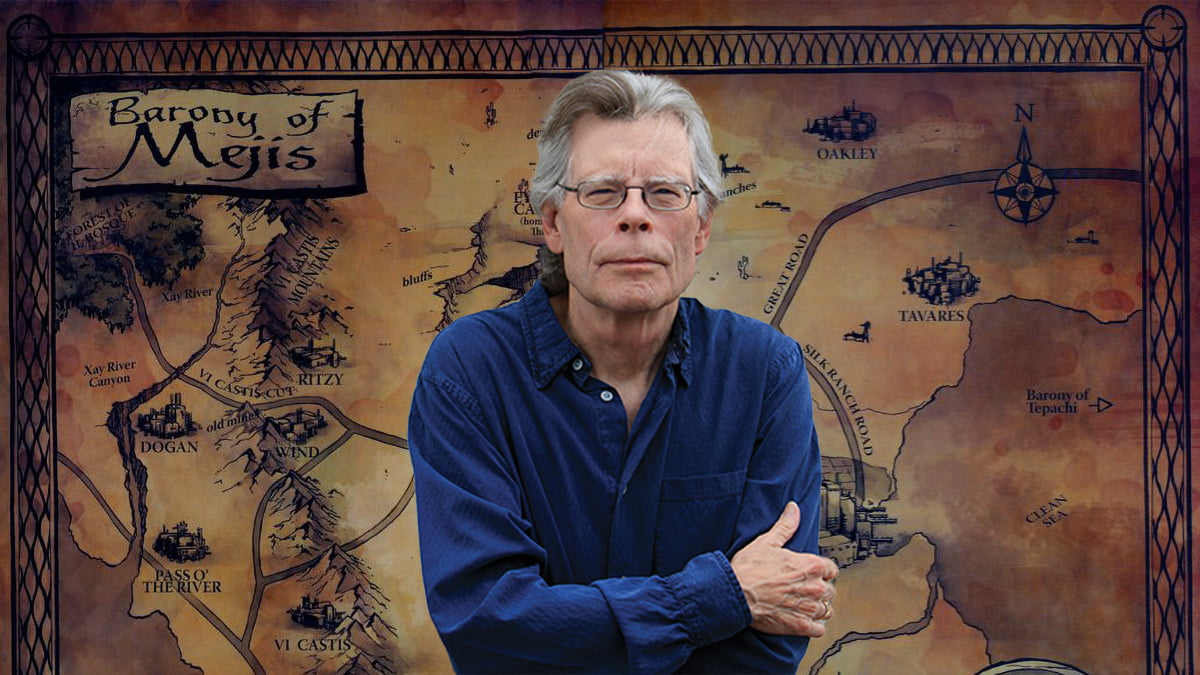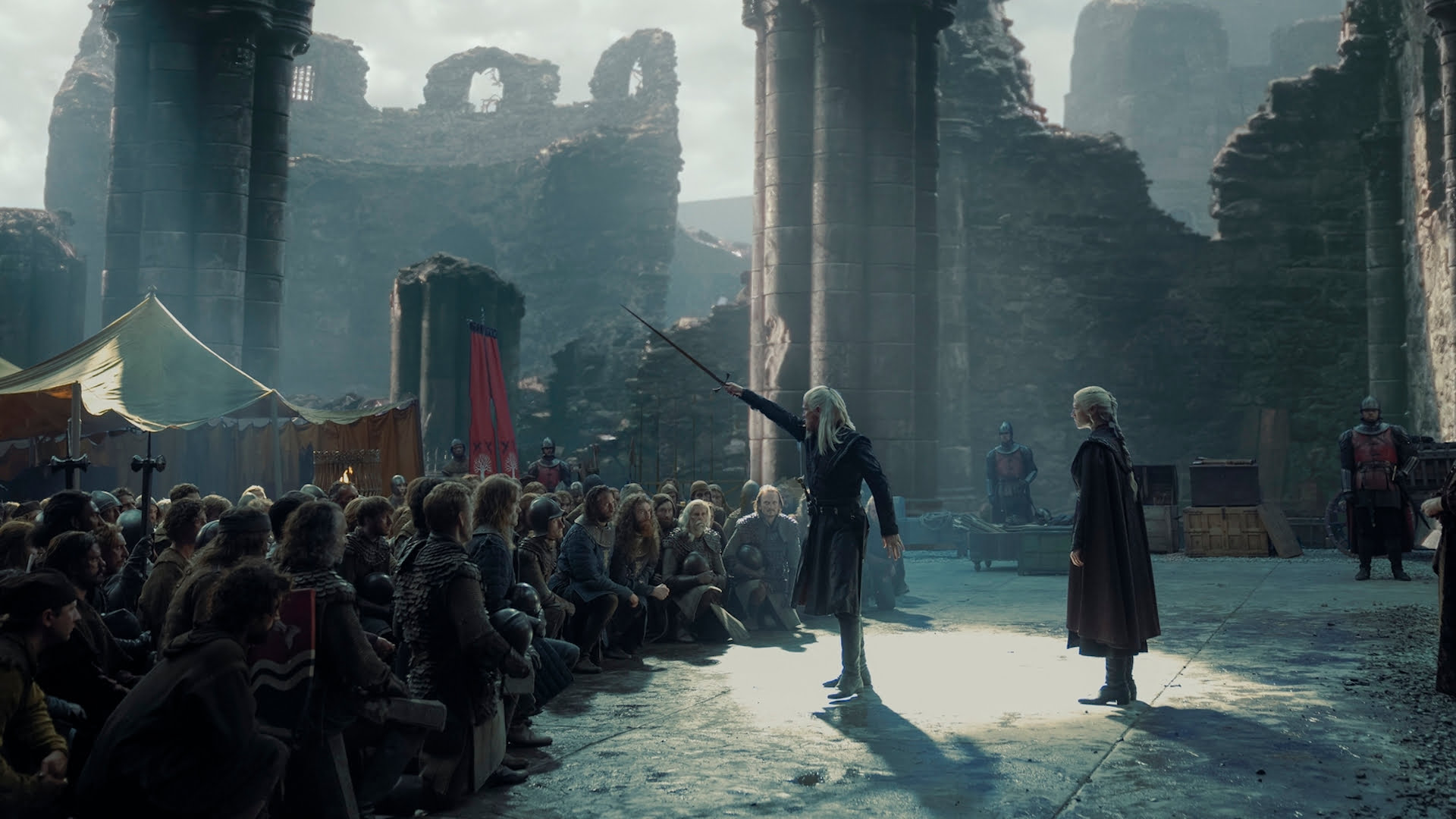One of the core concepts of Brandon Sanderson’s Cosmere universe is that of the Shards. But what exactly those Shards are is revealed slowly, over many different books, making it hard to put it all together. In this article, we’ll explain what Shards are and how they came to be; we’ll also look at all of the known Shards and the specifics of what they’ve been up to since the events of the Shattering; finally, we’ll take a look at exactly where Brandon Sanderson first reveals each Shard’s name, just for fun.
The nature of Shards is an integral part of the larger Cosmere narrative, so if you haven’t read all of the books, know that this article has minor spoilers for most Cosmere books, and major spoilers for the Mistborn series.
Below, we’ll get into details about every Shard currently revealed, but for now, here are all the known Shards of Adonalsium present in the Cosmere:
- Ambition
- Autonomy
- Cultivation
- Devotion
- Dominion
- Endowment
- Honor
- Invention
- Mercy
- Odium
- Preservation
- Ruin
- Valor
- Virtuosity
- Whimsy
- Reason
What is a Shard?
In brief, a Shard is a specific piece of the power of creation, and the spiritual energy that makes up the Cosmere. Shards are held by Vessels — living beings that hold the power of the Shard.
Intents
Vessels aren’t completely free to do as they please, however: each Shard has an Intent — a specific urge or motivation that drives the Shard. The Shard of Ruin is driven to destroy things (to ruin them), for example, while the Shard of Preservation seeks to keep things stable (to preserve them). A Vessel will struggle to act in ways that contradict the Intent of their Shard, and the Shards tend to influence their Vessels over time. That doesn’t mean that the Vessel can’t generally do what they want, just that certain things will be much harder to do, and some actions may indeed be impossible.
Powers
The powers of a Shard are vast, with each Shard functionally acting as a god. Shards have moved planets, created entire living species and modified the genetics of others. Shards can see the various possibilities of the future to varying degrees, and can appear anywhere on a world they have Invested with their power. Most of the magic we see in the Cosmere is directly linked to the Shards that have imbued their power into that planet.
Because each Shard holds a specific slice of the powers of creation, they are connected to the Investiture in the entire Cosmere. To again use Ruin and Preservation as an example, their presence exists in some way on every planet in the Cosmere that has sentient life, because life and death are of Preservation and Ruin, respectively. However, Shards do not have limitless awareness, and generally aren’t able to utilize this universal presence in a meaningful way.
The Shattering
Now we know what a Shard is, but what about where they come from? Well, to understand that, we’ve got to go back to an important event that happened long ago: The Shattering.
All of the power of the Shards was originally contained in one god-like being, known as Adonalsium. This being created the Cosmere some 10,000 years before the events of the True Desolation on Roshar. Almost nothing is known about Adonalsium or why they chose to create the Cosmere.
16 individuals conspired to destroy Adonalsium, and in doing so splintered the god into 16 Shards. They then took up those Shards for themselves. This occurred on the planet of Yolen. Some of the conspirators participated because they sought the power Adonalsium held, while others believed it was a necessary action.
While Hoid turned down a shard, he was involved in the Shattering, so we can assume he felt it was something that had to be done.
Descriptions, Vessels, & Histories
In this section, we will describe each Shard and its Intent, name its Vessel if known, and describe all known activities of the Shard in question.
Ambition
Ambition was held by Uli Da, a Sho Del female who was involved in the Shattering. The Shard of Ambition was splintered by Odium after being attacked and wounded in the Threnody system. The fight in the Threnody system damaged the Spiritual Realm and caused strange problems on Threnody (it is possible Ambition’s splintering is the reason there are dangerous Cognitive Shadows on the planet).
Ambition’s Intent is unknown, but we can assume relates strongly to the concept of ambition. Brandon has said that if Ambition was a Magic the Gathering card, it would be mono-black, and Endowment has stated that Uli Da was “going to be a problem”.
Autonomy
Autonomy is held by Bavadin, who was present at the Shattering. They may have originally been a human female, but now have a number of personas of both genders, human or otherwise. The Shard ended up in the Taldain System. It seems to have some kind of alliance with Odium, and possibly assisted Odium with killing Devotion and Dominion. Autonomy has isolated Taldain from the rest of the Cosmere, preventing travel to or from the planet — they have also actively encouraged and supported technological advancement on Taldain.
Autonomy’s Intent is to grant people autonomy, naturally; giving them the freedom to be individuals — she also seems to encourage the survival of the fittest. The Shard has sent out Avatars to other planets in the Cosmere — Splinters of itself that can act independently (which seems to match the Shard’s Intent quite well, no?). One Avatar is Patji on First of the Sun, and another is being manifested on Obrodai. Autonomy started a religion on Scadrial, and almost allowed Telsin Ladrian to become her Avatar, but Autonomy ended up withdrawing her power.
Cultivation
Cultivation is held by the female dragon Koravellium Avast, who participated in the Shattering. She came to the planet Roshar with the Shard of Honor, with whom she had a romantic relationship. Both Shards acted as gods for the humanoid species currently on the planet, the singers. At some later date, the Shard Odium arrived on Roshar with humans; following this, Honor and Cultivation became the gods of the humans and Odium became the god of the singers. Cultivation and Honor battled Odium, and succeeded in trapping the Shard on another planet in the system, but Honor was killed in the struggle.
Cultivation’s Intent involves encouraging growth and change in all things — cultivating them. At some point created the Nightwatcher, a powerful spren that grants pilgrims a boon and a curse. She has specifically cultivated multiple humans on Roshar in order to further a plan that has yet to be revealed — this list includes Dalinar Kholin, Taravangian, and Lift. Part of her plan seems to involve Dalinar Kholin take up the remnants of the Shard of Honor present in the Spiritual Realm.
Devotion
Devotion was held by Aona, a being present at the Shattering. She and Dominion went to the planet of Sel, where they influenced the planet mostly through their Investiture and the affects that it had on the planet and its people. Odium (possibly with help from Autonomy) killed Devotion and Dominion, Splintering them. Somehow, the power of both dead Shards was pushed into the Spiritual realm, to make it inaccessible and to prevent it from becoming sentient (though it seems to be doing so anyway).
Devotion’s Intent is not well known, but we can glean a bit from the way a Splinter of Devotion, seon Ien, spoke of his desire to serve those he loved.
Dominion
Dominion was held by Skai, a being present at the Shattering. Her story is the same as Devotion’s (see above): went to Sel, got killed by Odium and Splintered, the remnants pushed into the Spiritual realm as much as possible. Domonion’s Intent is also not well known, but again we can learn something from the Splinters of Dominion, the skaze, who seem to work hard at maintaining power and control in the politics of the country they inhabit — seeking dominion, in other words.
Endowment
Endowment is held by Edgli, a being present at the Shattering. She went to Nalthis, where Endownment eventually started creating the Returned (dead humans blessed with brought back to life and kept alive via invested Breath). Endownment speaks directly to the Returned, showing them visions of the future and giving them the opportunity to act based on that information. Endowment seems uninterested in participating in the wider Cosmere, as she rebuffed Hoid when he attempted to build a coalition against Odium.
Endownment’s Intent isn’t well understood yet, but she certainly endows life upon the Returned, and the way Breath works on Nalthis lets people endow Investiture to one another also matches the Shard’s title.
Invention
Invention’s Vessel is unknown — as far as we know, it was never Splintered and has remained in the hands of whoever picked it up at the Shattering. Its Intent is unknown as well, but certainly revolves around new ideas and/or creations.
Mercy
Mercy’s Vessel is also unknown, and has remained with the same Vessel since the shattering. Mercy was part of the battle between Odium and Ambition. It isn’t clear whose side the Shard was on — you might think a Shard of Mercy would have been protecting the victim, but perhaps ending the battle sooner was merciful… Mercy’s Intent is equally unclear, but we can assume is based in the concept of being merciful.
Odium & Honor (Retribution)
Odium & Honor are both held by Taravangian, a human from Roshar, who first became Odium’s Vessel during the events of the True Desolation on Roshar. He then became Honor’s Vessel as well, and with the power of both Shards together, became Retribution.
Previously, the Shard of Odium was held by Rayse, a human present at the Shattering. Unlike the other known Shards, Odium never settled on one planet and Invested it; instead he roamed the Cosmere, killing other Shards, with the goal of becoming the only Shard (because his Intent is odium, or hatred). He sucessfully Splintered Dominion and Devotion, and wounded Ambition. Next, he went to the Rosharan system, and attempted to kill Honor and Cultivation. He successfully killed Honor, but Honor and Cultivation managed to trap Odium on the planet Braize before Honor died.
Odium’s Intent is a matter of some debate — it has been described as the Shard of hatred, but when Rayse held the Shard he claimed he was a god of Passion and extreme emotions in general. This is supported by how the Unmade, Splinters of Odium, focus on different passions: The Thrill is the passion of combat, while The Revel is the passion of excess. But when Taravangian took up the Shard, he was almost overwhelmed with an urge to destroy, so it seems the truth lies somewhere in the middle.
Honor was held by Tavanast, who may have been human and was present at the Shattering. He was in a romantic relationship with Cultivation, and together they went to the Rosharan system and acted as the gods of the native humanoids there, the singers. When Odium brought humans to Roshar, Honor and Cultivation ended up as the humans’ gods at some point, with Odium becoming god of the singers. Both shards battled Odium, with humans and singers fighting a generational war.
During this conflict, Honor and Cultivation combined their powers to create the Sibling, the spren of Urithiru. Eventually, Odium managed to kill Honor, but the Shard remains available for someone to take up, and Honor left behind informational visions for the Stormfather to give to someone who could help lead the humans during the final stage of the conflict. Honor’s Intent focuses on oaths and honoring those oaths — near the end of Tavanast’s life, he began caring more about oaths than anything else.
The power of Honor abandoned Tanavast after he betrayed Ba-Ado-Mishram, as Honor’s Intent of Oathkeeping was at odds with Tavanast’s actions. Honor’s power plotted with Tavanast to bind Rayse to a contest of champions, and find an individual capable of once again taking up the power — a worthy champion who could win the planned contest and prove themselves worthy of Honor.
This ended up being Dalinar, who, after becoming a Bondsmith, traveled to the Spiritual Realm and took up the Shard of Honor. However, he renounced his oaths, letting the power go, in order to trick Taravangian (Odium) into taking up the Shard. By renouncing his oaths and allowing Taravangian to take up the Shard, Dalinar simultaneously freed Taravangian from the Rosharan system and made him the most powerful and dangerous being in the Cosmere. This in turn made it impossible for the rest of the Shards to continue ignoring Odium and the threat he posed.
Preservation & Ruin (Harmony)
Preservation & Ruin are both held by Sazed, a Terris who picked up the Shards during the Catacendre. Originally, Preservation was held by Leras, who was present at the Shattering with Ati, the original Vessel of Ruin. They traveled together to the Scadrian system, and created the planet of Scadrial. They made a deal to create the planet and its life, with Preservation putting slightly more of his power into their creation, guaranteeing that Ruin could one day destroy the planet as he wished.
However, Preservation broke their agreement, sacrificing most of his remaining power to trap Ruin in the Well of Ascension. Vin freed Ruin from the Well during the events of the Final Empire, and Preservation dies soon after. Kelsier took up the Shard of Preservation, who later gave the power to Vin — she in turn used it to destroy Ruin’s Vessel, sacrificing herself in the process. Sazed then took up both Shards, becoming Harmony.
Preservation’s Intent is to keep things as they are, while Ruin’s Intent is to change things, generally via destruction.
Valor
Valor’s vessel is the dragon Medelantorius. Their history is unknown, though is seems very likely the dragon was present at the Shattering. Harmony considers the Vessel of Valor “reasonable”, and it seems likely the Shard’s Intent involves being brave. Tanavast (former Vessel of Honor) refers to Medelantorius as a warrior.
Virtuosity
Virtuosity’s Vessel is unknown. Brandon Sanderson has told us Virtuosity spent her time “exploring the artistic expressions of the cosmere… and choosing not to settle in one location”. The Shard then Splintered herself, possibly intentionally, in the UTol system. The Shard’s Intent appears focused on art, with the term virtuosity referring to being a virtuoso at a given medium.
Whimsy
Whimsy’s Vessel and history is unknown. Harmony’s communications with the Shard led him to believe she would not be useful in the battle against Odium. Whimsy’s Intent is largely unknown, but we do know the Shard isn’t interested in planning or being deliberate.
Reason
Reason’s Vessel is Euridrius, history unknown. Reason has managed to hide themself from the other Shards in the Cosmere, for unknown reasons.
Sources
Curious readers might be interested to learn exactly where each Shard’s name was revealed — I know I couldn’t remember where Valor was from at first when making this list! So, below you’ll find descriptions of when and where Brandon Sanderson revealed each Shard’s identity for the first time:
- Ambition is first mentioned in Arcanum Unbounded, in the section describing the Threnodite system, in regards to Ambition’s clash with Odium.
- Autonomy is revealed in Mistborn: Secret History by Khriss when she is telling Kelsier about the Shards.
- Cultivation is first mentioned by name in the visions the Stormfather gives Dalinar; Honor mentions her.
- Devotion is first mentioned only via the Vessel’s name, Aona, in the Way of Kings Ch. 22 epigraph; the shard is named in Arcanum Unbounded, in the section describing the Selish system. Sanderson has confirmed Aona was the original Vessel of Devotion.
- Dominion is also first mentioned via Vessel name, in the same Way of Kings epigraph as Devotion. Brandon revealed the shard’s name and location at a signing.
- Endowment is The Voice that calls Lightsong back to life in Warbreaker — Brandon revealed this Shard’s name during a Q&A, and the Shard is mentioned in-text in the Rhythm of War epigraph for Ch. 24.
- Honor is first named in the Way of Kings Ch. 35 Epigraph (and soon after by the Stormfather when he calls Kaladin “Child of Tavanast/Child of Honor), but once again wasn’t confirmed to be a Shard of Adonalsium until Brandon revealed it.
- Invention is first mentioned by name in the Rhythm of War Ch. 24 epigraph.
- Mercy is mentioned in the following epigraph, Rhythm of War Ch. 25.
- Odium‘s name is revealed in The Way of Kings Chapter 46, in Kaladin’s vision from the Stormfather
- Preservation is named by OreSeur in Ch. 33 of The Well of Ascension, when he tells Vin that the kandra are of Preservation.
- Ruin is mentioned in the same scene as Preservation, Ch. 33 of The Well of Ascension
- Valor is one of many Shards named in Rhythm of War Ch. 25’s epigraph.
- Virtuosity is named in the first chapter of Yumi and the Nightmare Painter, when the narrator is speculating on why one star shines through the shroud.
- Whimsy is first mentioned by name in the Rhythm of War Ch. 25 epigraph.
- The 16th shard is currently Unknown.
This was a tricky task — if we missed an earlier mention of a Shard, please let us know in the comments below!
Art at the top of the page is a modified version of a depiction of the Shattering, by Connor Chamberlain






